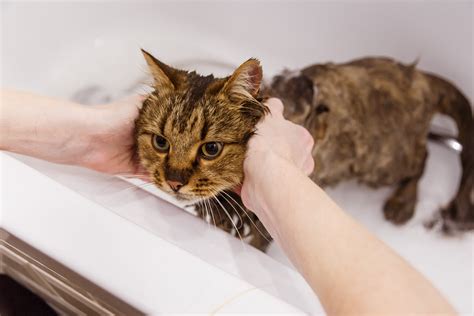Bathing a cat may seem like a daunting task, but there are times when it’s necessary for their health and well-being. Cats are generally very good at grooming themselves, but certain circumstances—such as matting, health conditions, or exposure to something toxic—might require you to step in and help. Here’s what you need to know about bathing your cat:
-
When Should You Bathe Your Cat?
While most cats do a great job of grooming themselves, there are situations where they may need a bath. For instance, if your cat gets into something sticky, smelly, or harmful (like oil or chemicals), a bath may be necessary. Long-haired cats might also need a bath to prevent matting and tangling. Cats with certain skin conditions may also benefit from medicated baths, as recommended by a veterinarian. -
Prepare the Right Supplies
Before you start, make sure you have everything you need. You’ll need a cat-friendly shampoo (never use human shampoo, as it can irritate your cat’s skin), a towel, a cup or gentle spray nozzle for rinsing, and a safe place to bathe your cat (a sink, bathtub, or shower stall works well). If your cat isn’t accustomed to baths, consider using a calming spray or pheromone diffuser to help reduce anxiety. -
How to Bathe Your Cat
Start by gently wetting your cat with lukewarm water. Avoid getting water directly on their head and face to make the experience less stressful. Apply a small amount of cat-friendly shampoo and gently lather. Be sure to focus on the areas that need cleaning, such as the paws, tail, and belly. Rinse thoroughly, ensuring that no shampoo residue is left behind. -
Dealing with Your Cat’s Stress
Cats aren’t typically fond of water, and some may become stressed during a bath. Speak to your cat in a calm voice, and keep your movements slow and gentle to avoid startling them. If your cat becomes very anxious or aggressive, you may want to stop and try again later or consult a professional groomer. -
Drying Your Cat
After the bath, wrap your cat in a towel to absorb the excess water. Gently pat the fur—don’t rub too hard, as it can cause tangles or discomfort. If your cat tolerates it, you can use a blow dryer on the lowest setting to help dry their fur. Keep the dryer at a distance and ensure it’s not too hot. -
Regular Grooming Between Baths
Frequent brushing can help keep your cat’s coat in good condition and reduce the need for baths. For long-haired cats, regular brushing helps prevent matting and tangling. Even short-haired cats can benefit from periodic brushing to reduce shedding and hairballs.
Remember, most cats don’t need frequent baths, and it’s essential to only bathe them when absolutely necessary. With patience and the right approach, bath time can become a less stressful experience for both you and your cat. Always consult your veterinarian if you’re unsure about whether your cat needs a bath or if you have concerns about their skin or coat health.
 PAWS AND WHISKERS PET CARE
PAWS AND WHISKERS PET CARE




